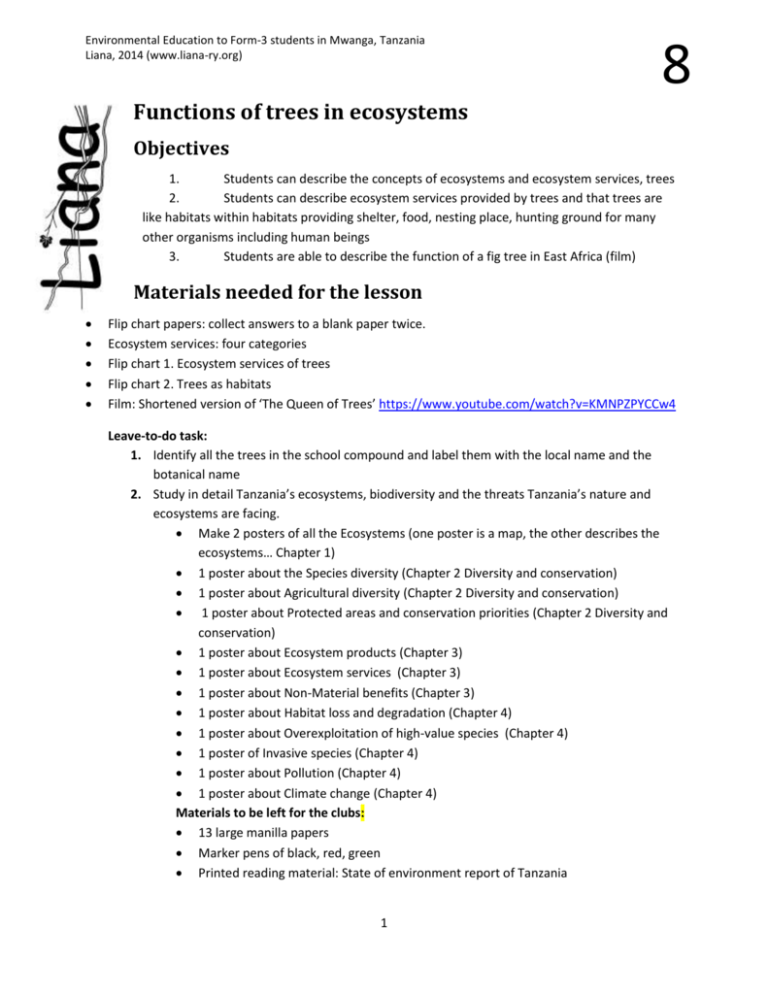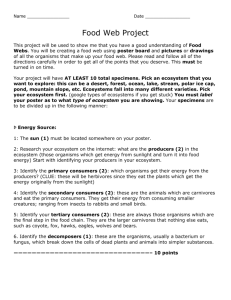Tree - Liana
advertisement

Environmental Education to Form-3 students in Mwanga, Tanzania Liana, 2014 (www.liana-ry.org) Functions of trees in ecosystems 8 Objectives 1. Students can describe the concepts of ecosystems and ecosystem services, trees 2. Students can describe ecosystem services provided by trees and that trees are like habitats within habitats providing shelter, food, nesting place, hunting ground for many other organisms including human beings 3. Students are able to describe the function of a fig tree in East Africa (film) Materials needed for the lesson Flip chart papers: collect answers to a blank paper twice. Ecosystem services: four categories Flip chart 1. Ecosystem services of trees Flip chart 2. Trees as habitats Film: Shortened version of ‘The Queen of Trees’ https://www.youtube.com/watch?v=KMNPZPYCCw4 Leave-to-do task: 1. Identify all the trees in the school compound and label them with the local name and the botanical name 2. Study in detail Tanzania’s ecosystems, biodiversity and the threats Tanzania’s nature and ecosystems are facing. Make 2 posters of all the Ecosystems (one poster is a map, the other describes the ecosystems… Chapter 1) 1 poster about the Species diversity (Chapter 2 Diversity and conservation) 1 poster about Agricultural diversity (Chapter 2 Diversity and conservation) 1 poster about Protected areas and conservation priorities (Chapter 2 Diversity and conservation) 1 poster about Ecosystem products (Chapter 3) 1 poster about Ecosystem services (Chapter 3) 1 poster about Non-Material benefits (Chapter 3) 1 poster about Habitat loss and degradation (Chapter 4) 1 poster about Overexploitation of high-value species (Chapter 4) 1 poster of Invasive species (Chapter 4) 1 poster about Pollution (Chapter 4) 1 poster about Climate change (Chapter 4) Materials to be left for the clubs: 13 large manilla papers Marker pens of black, red, green Printed reading material: State of environment report of Tanzania 1 Environmental Education to Form-3 students in Mwanga, Tanzania Liana, 2014 (www.liana-ry.org) Sequence of the lesson List to the students the learning objectives as above 1. Ensure concepts are understood: Elicit from the students and help to get the definitions Tree: In botany, a tree is a perennial plant with an elongated stem, or trunk, supporting branches and leaves in most species. Habitat: A habitat is an ecological or environmental area that is inhabited by a particular species of animal, plant, or other type of organism. Ecosystem: An ecosystem is a community of living organisms (plants, animals and microbes) in conjunction with the nonliving components of their environment (things like air, water and mineral soil), interacting as a system. Flip chart 1: Ecosystem services: Services that ecosystem provide. They are divided into four broad categories: 1. supporting, such as nutrient cycles and crop pollination 2. provisioning, such as the production of food and water 3. regulating, such as the control of climate and disease 4. cultural, such as spiritual and recreational benefits 2. The ecosystem services that trees provide (Flip chart 2) 1. Water storage and retention – Forests catch, hold and recycle rainwater, moderating water flows. Plants absorb rainwater and then release it back into the air. 2. Erosion control – Retention of soil within an ecosystem. 3. Carbon and oxygen cycles – Plants absorb carbon dioxide and release oxygen back into the air, creating a breathable atmosphere. 4. Nitrogen Cycle – Nitrogen is essential for plant growth. Bacteria living on some tree roots convert nitrogen from the atmosphere into a form that the tree can use. Creatures feeding on these trees release nitrogen in their waste products. When the waste is broken down it is released back into the atmosphere. 5. Harbouring pollinators – This can be vital to the success of some of our food crops. 6. Biological control – Many predators of crop pests survive on alternative prey in hedgerows ready to disperse once pests appear. 7. Refugia – Trees act as nurseries and habitats. Trees are refugia for woodland species in the farmed landscape. 8. Food production – Nuts, fruits and berries. 9. Energy and building materials – firewood and timber 10. Transforming energy from the sun into stored chemical energy – This is the foundation for virtually all food webs. 11. Genetic resource – Some tree species exist as sub-populations of locally adapted species. 2 Environmental Education to Form-3 students in Mwanga, Tanzania Liana, 2014 (www.liana-ry.org) 12. Carbon sequestration – binding carbon from the atmosphere. Mitigation of anthropogenic climate change. 13. Provision of sites for particulate deposition –Trees can reduce the effects of pollution by intercepting them on their leaves and thus having a filtering effect on the air. 14. Cultural and esthetic value Provide a short introduction to the film. It is a film about a sycamore fig tree in East Africa. The story is about the services the tree provides to other organisms It is also a story about the extraordinary pollination of the tree o the tree does not have visible flowers o flowers are inside the figs/fruits into which the fig wasp bores itself, hatches and is then released in order to fly away and take the pollen of the tree with it to another tree When you watch it try to keep in your mind all the creatures that benefit from the tree (don’t write while watching, concentrate in watching only) Show the film (17 min) 3. Tree are habitats within habitats Ask students which creatures the fig tree provides and what it provides to them (e.g. nesting site to a hornbill, sugar for beetles, ants eat the sugary feces of the beetles…) List the answers on a flip chart as they come, add more if they don’t remember Introduce the leave-to-do task. 3







